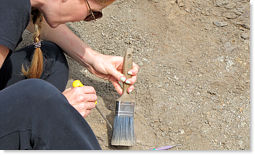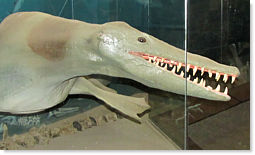
Holy Mosasaur! It's the T-rex of the Sea! |
By Doug Collicutt |
It was a beautiful day in early September. We'd been digging for about two hours, my back was sore and I wasn't sure if my knees were going to get me back to the car, but I was having a great time. I was ahead on the fossil-find count and feeling smug. I had found a Mosasaur rib bone, a Hesperornis leg bone and couple of other pieces of vertebrae, possibly from a Plesiosaur. Then Shauna, my fellow guest-paleontologist-for-a-day, who had found a couple of interesting things already, including a small shark tooth, held up something for Joey, our guide, to identify.
"That," he pronounced, "is a kick-ass Mosasaur tooth". Damn, a three-point shot at the buzzer and a win for Shauna. I admitted defeat and we packed up our gear, leaving our hard-won treasures in place for real paleontologists to later catalogue and collect.
Joseph, "Joey" Hatcher, our guide for the afternoon's dig is actually curator, chief paleontologist and acting director of the Canadian Fossil Discovery Centre (CFDC), based in Morden, Manitoba. Shauna Hewson, Education Coordinator for Wildlife Haven, a wildlife rescue and rehabilitation centre, had recently accepted a position on the CFDC's Scientific, Education and Technology Committee and was invited out for the day's committee meeting, plus some familiarization activities, which included our trip to a local fossil dig site and a guided tour of the centre's museum. Shauna wrangled an invitation for me to join her for the day, and since I had been meaning to visit the CFDC for years I was happy to tag along. It was a great chance to learn about some of Manitoba's extinct critters, an aspect of our province's biodiversity that's been overlooked for too long in NatureNorth.com.
|
At the Dig
In the case of the Manitoba escarpment near Morden, what lies beneath the ground are some pretty cool fossils. Our day at the CFDC started with a trip to one of their fossils digs in the Manitoba escarpment just west of the town of Morden. When we reached the dig site, we had a little side-activity to deal with first. Shauna and I had stopped off at Wildlife Haven to pick up a Red-tailed Hawk to be released. The hawk had originally been found in poor condition near Morden and transported to the Wildlife Haven facility near Ile des Chenes. It was healthy now and due to be released, so as we were heading to the right location anyway, along it came. I think it made Joey's day when he got the chance to help release that beautiful bird.
With the hawk on its way, we got down to business looking for fossils. The first thing that surprised me when we got to the actual site that was being excavated was the condition of the ground. The fossil bed didn't lie in a mass of limestone or sandstone rock, it was a loose and rather soft mixture of shales and what seemed like clay. And the layer containing the fossils wasn't that deep in the ground This wasn't the side of a deep rocky canyon, it was the edge of a little gully, a fairly recent wash-out that had resulted from the installation of a road culvert only a few decades earlier. You'd think that 80 million years would pile up more stuff on top of the fossils, but once you learn more about the local geology (see link above) it makes more sense.
|
After Joey primed us about the geology of the region and the history of the specific site where we were about to dig we got to work. Our tools consisted of a pointed screw driver and a paint brush. The instructions were simple: clear off the overburden from the fossil layer, then carefully probe and brush until you hit something that looks like a fossil. After a few responses from Joey of "no, that's a rock", Shauna and I got the hang of things and began turning up real fossils. Now, searching for anything is a lot more fun when you actually start finding worthwhile stuff, so when Shauna turned up a shark tooth in short order it got us fired up to find more.
As we dug, or perhaps it would be better to say "probed" around in the ground, we peppered Joey with questions about the site, the fossils and the museum, and he happily indulged our curiosity. A couple of hours passed quickly, though I will admit to going back to my car and grabbing a small pillow to cushion my aging knees, and we found 8 or 10 significant pieces from various critters.
Back at the Museum
When we returned to the CFDC's museum, currently housed in the Morden Community Centre (but I understand plans might be in the works for a new museum building), we were treated to a guided tour of the display galleries. There are two main galleries, one jam-packed with displays and dioramas depicting the geology and biology of the region during Cretaceous times (145 - 66 million years ago) as well as in current times, showing how the Bentonite mining operations lead to discovery of the fossil beds.
The second gallery is one large hall dedicated to "Bruce", the museum's prize Mosasaur. It needed to be a large hall to house all 13 m (43 feet) of Bruce, the largest Mosasaur skeleton ever found in Canada. (A European specimen of another species of Mosasaur is thought to have been about 15 m (49 feet) long.) Bruce is a "must see" in my books. You have to be there standing next to him to appreciate the size and potential ferocity of such a creature. It's no wonder people refer to animals like Bruce (technically a Hainosaurus pembinensis) as the T-rex's of the ocean.
Being VIP's for the day we also got the behind-the-scenes tour as well. We toured the storage and preparation areas and viewed the racks and racks of fossils that make up the largest collection of Cretaceous marine reptile fossils in Canada.
The Cool Critters
Though the CFDC is home to quite a number of species of ancient critters, there are a few worth mentioning here. Of course, there's the Mosasaurs, like Bruce, marine reptiles with paddle-like limbs for steering and a long tail that propelled them through the water much as crocodiles do today. Mosasaurs were one of the apex predators in Cretaceous seas, eating pretty much whatever came along including Plesiosaurs, giant fish and even other Mosasaurs. It's thought that most of their prey items were gulped down whole! (Click for pic!)
And then there's the "Piranha on steroids", as Joey called it, Xiphactinus, or "Bulldog Tarpon". This fish grew to 6 m (20 ft) in length and had teeth bigger than your fingers! It also ate pretty much whatever it wanted, but was found inside the stomach region of more than one Mosasaur, so it was at least one step down from the top of the food chain. (Click for pic!)
How about an aquatic bird with teeth! That was Hesperornis, looking a bit like a giant loon, it grew to just under 2 m (6 ft) in length. It was flightless, its wings were tiny, and it had rows of sharp peg-like teeth in its beak, perfect for grabbing onto fish. (Click for pic!)
You would not catch me swimming in any Cretaceous seas!
Closing Thoughts
Turns out, the Canadian Fossil Discovery Centre is one of Manitoba's coolest science venues. Learning about the amazing creatures that once patrolled the ancient seas above what is now southern Manitoba was great fun, even for an old codger like me. But the kicker was being able to get some hands-on experience digging fossils out of the ground. Imagine yourself being the first person to expose a piece of the past, uncovering the remains of a creature that has lain hidden for 80 million years! So, when (not if) you make the trip to Morden be sure to sign up for a Fossil Dig Adventure Tour. Perhaps Bruce's big brother is waiting out there for you to find!
Thanks for learning about Manitoba Mosasaurs and the Canadian Fossil Discovery Centre.
Be sure to head to Morden for a visit! Bye for now!
If you enjoyed this article, here's more you might like:
Night Crawlers | Northern Crayfish | Wild Cucumbers
| You can help NatureNorth produce more great articles with a secure donation through PayPal. Our Google Adsense ads pay our server costs, but that's about it. To learn more follow this link: Support NatureNorth. Thank-you! | |
Return to: Fall Issue | NatureNorth Front page



